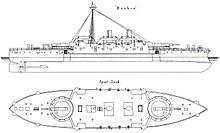Admiral-class ironclad
 HMS Anson (circa 1897) | |
| Class overview | |
|---|---|
| Name: | Admiral class |
| Operators: |
|
| Preceded by: | Colossus class |
| Succeeded by: | Victoria class |
| In commission: | 1888–1910 |
| Completed: | 6 |
| Scrapped: | 6 |
| General characteristics Anson and Camperdown except where stated[1] | |
| Type: | Ironclad battleship |
| Displacement: | 10,600 long tons (10,800 t) |
| Length: | 330 ft (101 m) |
| Beam: | 68 ft 6 in (21 m) |
| Draught: | 27 ft 10 in (8 m) |
| Propulsion: | |
| Speed: | |
| Complement: | 530 |
| Armament: |
|
| Armour: |
|
The British Royal Navy's ironclad Admiral-class battleships of the 1880s followed the pattern of the Devastation class in having the main armament on centreline mounts fore and aft of the superstructure. This pattern was followed by most following British designs until HMS Dreadnought in 1906. They were known as the Admiral class because they were all named after British admirals, such as Admiral George Anson.
Service history
Collingwood
Collingwood was commissioned at Portsmouth on 1 July 1887 for Queen Victoria's Golden Jubilee Military Review, and was paid off into Reserve in August. She was posted to the Mediterranean, where she served from November 1889–March 1897. She was coastguard ship at Bantry from March 1897–June 1903, when she paid off into the reserve, where she remained until sold.

Rodney
Rodney was commissioned on 20 June 1888 into the Home Fleet. She was held in reserve until July 1889, and after taking part in manoevres until September she served with the Channel Fleet until May 1894. She was then posted to the Mediterranean, remaining there until 1897. Thereafter she was coastguard ship at Queensferry until February 1901. She remained in reserve until being sold in 1909.
Howe
Howe was delivered at Portsmouth on 15 November 1885, complete except for her main armament. She was commissioned in July 1889 to take part in fleet manoevres. Finally fully armed, she was posted to the Channel Fleet in May 1890, and then to the Mediterranean. On 2 November 1892, she grounded on Ferrol[4] Rock, and was salvaged with great difficulty, being finally freed on 30 March 1893. She paid off at Chatham for repairs and overhaul, and then served in the Mediterranean until 1896, when she became port guard ship at Queenstown. In 1901, she was relegated to the reserve, where she remained until sold in 1910.
Camperdown
Camperdown was commissioned at Portsmouth on 18 July 1889, and initially went into reserve. In December 1889 she was posted to the Mediterranean Fleet as flagship, where she remained until being posted as flagship of the Channel Fleet in May 1890. She was paid off in May 1892 into Fleet reserve, recommissioning in July 1892 into the Mediterranean Fleet. On 22 June 1893, she collided with and sank the battleship Victoria with 358 deaths, including Vice-Admiral Sir George Tryon (See Victoria for details). In September 1899, she went into Category B reserve, and in May 1900 into Dockyard reserve. In July 1900 she commissioned as a coast guard ship at Lough Swilly until May 1903. She was in reserve at Chatham until 1908, and was employed at Harwich as a berthing ship for submarines until she was sold in 1911.
Anson
Anson arrived at Portsmouth from the builder's yard in Pembroke in March 1887, and lay at anchor for two years, slowly completing for sea while waiting for her guns to be manufactured. She finally commissioned on 28 May 1889 as flagship of the Rear-Admiral, Channel Fleet. On 17 March 1891 passenger steamer SS Utopia accidentally collided with stationary Anson in the Bay of Gibraltar. 562 of Utopia's passengers and crew and two rescuers from HMS Immortalité were killed in the accident.[5] Anson did not report any injuries or damage.
In September 1893, Anson was transferred to the Mediterranean, where she served until January 1900, with a refit at Malta in 1896. She returned home and paid off at Devonport in January 1901, re-commissioning for the newly formed Home Fleet in March of the same year. In May 1904, Anson finally paid off into reserve, where she remained until sold on 13 July 1909.


Benbow
Benbow was commissioned on 14 June 1888 for the Mediterranean Fleet, with which she served until October 1891. She was then held in the Reserve until March 1894, with two short commissions to take part in manoevres. Until April 1904 she served as guardship at Greenock, and thereafter remained in the Reserve until sold in 1909.
References
- ↑ Chesneau & Kolesnik 1979, p. 29.
- 1 2 Chesneau & Kolesnik 1979, pp. 29–30.
- ↑ Chesneau & Kolesnik 1979, p. 30.
- ↑ "DISASTER TO THE HOWE, THE VESSEL A TOTAL LOSS: Telegram from Admiral Fairfax"(1892) The Manchester Guardian, 5th November 1892, Page 8: Manchester <<Reuter's agency says:... the Howe is not yet floted. Every effort is being made to secure her on the rocks. Appliances to save the ship will be despatched immediately by the British Admiralty. ... at the mouth of Ferrol harbour... The Captain-General sent a gunboat and several large arsenal barges to upload the Howe's ammunition, small artillery and stores. The large artillery was then moved to the port side, in order to make the ship lean towards the sea... it might be possible to effect temporary repairs and to float and dock the ship.>> (English)
- ↑ The Dead of the Utopia. The New York Times, 20 March 1891.
Bibliography
- Chesneau, Roger; Kolesnik, Eugene M. (1979). Conway's All the World's Fighting Ships, 1860–1905. London: Conway Maritime Press. ISBN 0-85177-133-5.
External links
| Wikimedia Commons has media related to Admiral class battleships. |